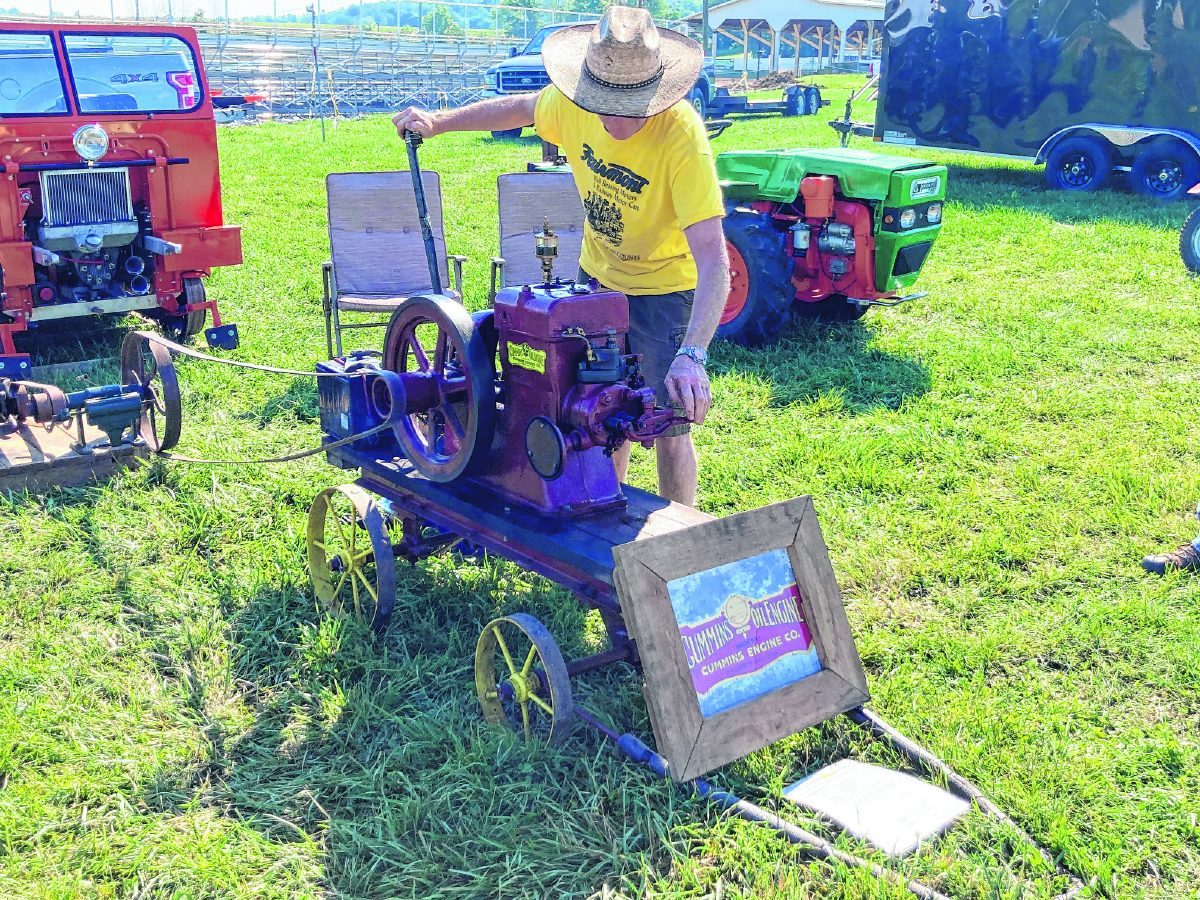
BROWNSTOWN
After a year off due to the global pandemic, the Jackson County Antique Machinery Show recently was able to make its return.
During the 12th show, flea markets, food vendors and people riding antique tractors could be seen spread around the Jackson County Fairgrounds.
Robert Bishop, president of the Jackson County Antique Machinery Association, said there were about 50 tractors and 65 engines at this year’s show. Normally, there are around 100 tractors in a year not in a pandemic.
He said he was glad to put the show on since last year’s show was canceled.
“It’s getting better all the time,” he said.
Don Tempest of North Vernon was among the participants. He brought two engines and one tractor with him to the show.
Running at two and a half horsepower, one of his engines was an early 1920s Rock Island hit-and-miss engine. The second one was an early 1920s Maynard hit-and-miss engine.
They’re called hit-and-miss due to the way speed is controlled on them. When trying to get up to a certain speed, the governor, a part used to control speed in an engine, will “hit” by closing the engine’s exhaust valve. After the engine is above its intended speed, the governor will “miss” by opening up the exhaust valve.
This process creates a cyclical “whoosh whoosh whoosh pop” sound that can be heard around antique engines or at the displays of such machinery including the Jackson County Fair and Fort Vallonia Days each year.
Tempets said it’s hard to figure out when they were manufactured because there weren’t serial numbers on them, but he figured out around the time period they were produced based on the parts and design of the engines.
For their time, Tempest said the engines would be used in anything that would use an electric motor today. A couple of examples he gave were meat grinders and hacksaws used on farms in the 1920s.
To maintain them, he said keeping them oiled is the most important part.
Tempest also exhibited a 1959 Farmall 240 tractor. It runs on 30 horsepower, and he said it’s his favorite tractor.
Only 3,500 of that kind of tractor were produced, and Tempest said it’s a rare sight at antique machinery shows in the area.
He said he’s excited that antique machinery shows are being put on again, and he has plans this year to attend more.
“It was a long, dry spell, it seemed like,” he said.
Eric Thompson from Brown County exhibited another relic at the show — one of the first mass-produced engines from Cummins in 1920. The company was established in 1919.
The engine was sold through the Sears catalog between 1919 and 1921. It costed $69 and was sold under the Thermoil brand, which was owned by Cummins.
In today’s money, Thompson said that would be around $2,000.
Between 1,000 to 2,000 engines of its kind were produced. It runs at one and a half horsepower and weighs 350 pounds.
Similar engines to it today weigh the same but run at about 100 times more power at 150 horsepower.
“In 100 years, we’ve made about 100 times improvement in power,” he said.
At the show, the engine was used to create fishing line by a contraption attached to it. The engine is a compression ignition engine, meaning compressed air is created through its mechanics to ignite fuel inside the engine to keep it running.
In comparison with a hit-and-miss engine, Thompson said compression ignition engines are more like a “hit-and-hit” engine.
Olive oil, peanut oil, kerosene and diesel fuel can be used to power the engine, Thompson said.
While one and a half horsepower sounds slow, Thompson said some original intentions for people who owned the engines were to save people from pumping water themselves or to grind corn to make flour.
Normally, the engine would be cranked by hand, but Thompson’s engine had an electric start so he wouldn’t have to do that. He said he got six stitches from hitting himself from the crank at one point.
Thompson also exhibited two Italian tractors, one from 1970 made by CAST and another from 1980 made by Pasquali. They were popular in vineyards in Italy for rough terrain.
Since he lives on the edge of the Hoosier National Forest, Thompson said he uses the CAST tractor to haul wood to heat his home.
Lastly, a Fairmont rail speeder was on display. It was invented after railroad workers would put Cummins engines on pump cars to have them ride on the tracks. In response, Fairmont invented the rail speeder so the engine was already in the car and could be put directly on the track. Workers would use them to inspect tracks and fix train signals.
It gets up to 35 mpg and has a 3-foot gauge, so it can only be ridden on narrow tracks. Thompson said there are only about three places he can ride them.
The rail speeder was phased out in the 1970s after the hi-rail was invented. It is a similar car that can be driven on the highway or the railroad. It also goes faster, has a larger cab and can have air conditioning and heating.
Thompson said he belongs to the North American Railcar Operators Association. In the organization, he goes on railroad rides on rail speeders with other members. He said on a ride, about 30 people will ride along.
